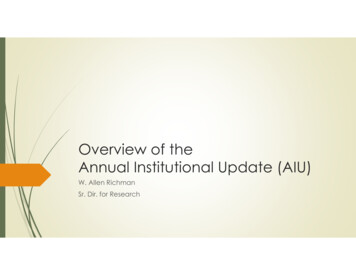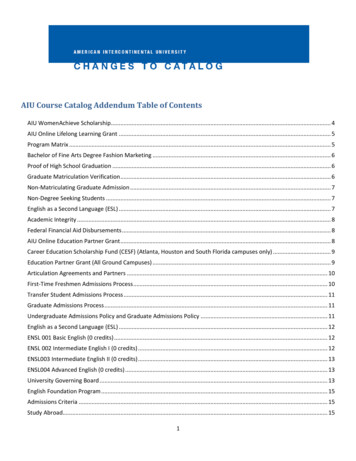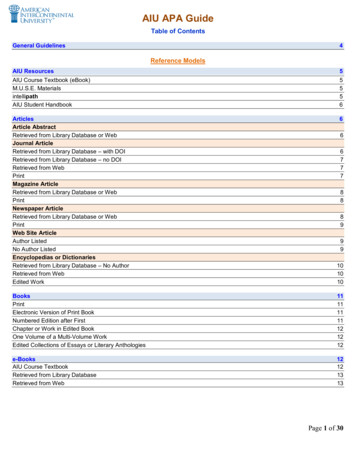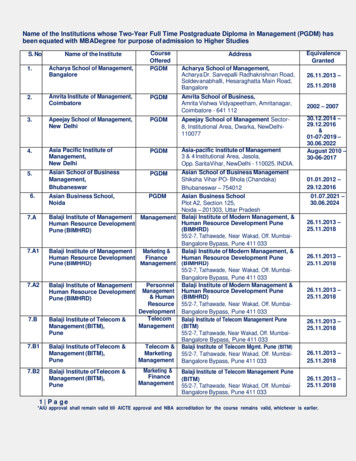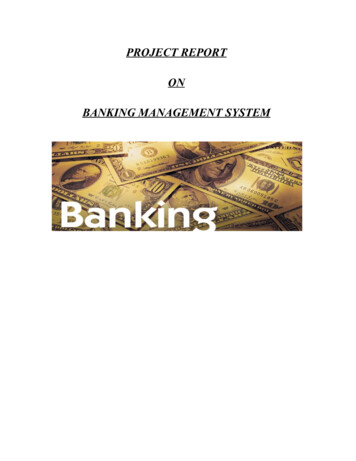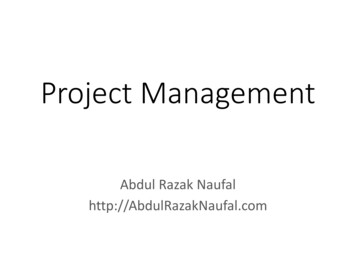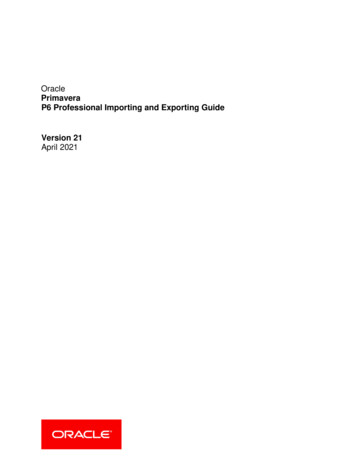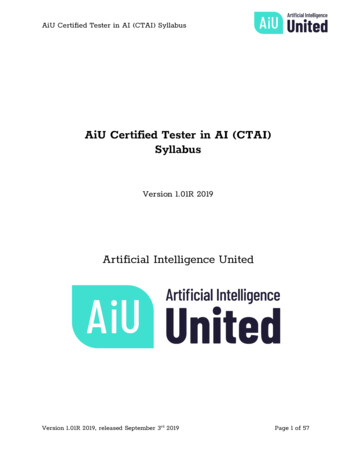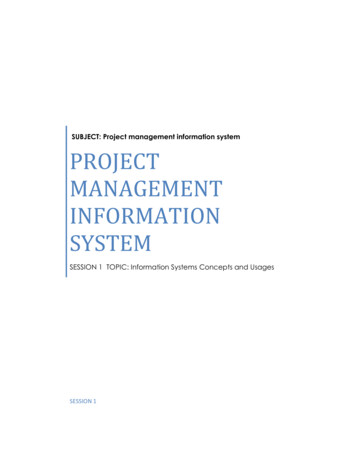
Transcription
SUBJECT: Project management information systemPROJECTMANAGEMENTINFORMATIONSYSTEMSESSION 1 TOPIC: Information Systems Concepts and UsagesSESSION 1
Subject: Project management information systemTopic:Session 1 Information Systems Concepts and UsagesProject management information systemA project management information system (PMIS) is the coherent organizationof the information required for an organization to execute projects successfully.A PMIS is typically one or more software applications and a methodical processfor collecting and using project information. These electronic systems "help [to]plan, execute, and close project management goals."[1] PMIS systems differ inscope, design and features depending upon an organisation's operationalrequirements.Contents 1 PMIS PMBOK 4th edition definition2 Project management information system softwareo 2.1 Characteristics of a PMIS Software3 Relationship between a PMS and PMIS4 References5 External linksPMIS PMBOK 4th edition definition[Project management information system (PMIS) [Tool]. The Project ManagementInformation System (PMIS), part of the enterprise environmental factors, providesaccess to an automated tool, such as a scheduling software tool, aconfiguration management system, an information collection and distributionsystem, or web interfaces to other online automated systems used during theDirect and Manage Project Execution effort.Project management information system softwareAt the center of any modern PMIS is software. Project management informationsystem can vary from something as simple as a File system containing MicrosoftExcel documents, to a full blown enterprise PMIS software.Characteristics of a PMIS SoftwareThe methodological process used to collect and organize project informationcan match normalized methodologies such as Project ManagementProfessional or PRINCE2.1
A PMIS Software supports all Project management knowledge areas such as :Integration Management, Project Scope Management, Project TimeManagement, Project Cost Management, Project Quality Management, ProjectHuman Resource Management, Project Communications Management, ProjectRisk Management, Project Procurement Management, and Project StakeholdersManagement.[2]A PMIS Software is a multi-user application, and can be cloud based or hostedon-premise.Relationship between a PMS and PMIS[A project management system (PMS) could be a part of a PMIS or sometimes anexternal tool beside project management information system. What a PMIS doesis to manage all stakeholders in a project such as the project owner, client,contractors, sub-contractors, in-house staff, workers, managers etc.[1]References[1. Jump up to: a b "Project Management Information System (PMIS)".Project-Management-Knowledge.com. Retrieved 13 November 2009.2. Jump up A Guide to the Project Management Body of Knowledge3. Project Management Information System (PMIS) are system tools andtechniques used in project management to deliver information. Projectmanagers use the techniques and tools to collect, combine and distributeinformation through electronic and manual means. Project ManagementInformation System (PMIS) is used by upper and lower management tocommunicate with each other.Project Management Information System (PMIS) help plan, execute andclose project management goals. During the planning process, projectmanagers use PMIS for budget framework such as estimating costs. TheProject Management Information System is also used to create a specificschedule and define the scope baseline. At the execution of the projectmanagement goals, the project management team collects informationinto one database. The PMIS is used to compare the baseline with theactual accomplishment of each activity, manage materials, collectfinancial data, and keep a record for reporting purposes. During the closeof the project, the Project Management Information System is used toreview the goals to check if the tasks were accomplished. Then, it is usedto create a final report of the project close.To conclude, the project management information system (PMIS) is usedto plan schedules, budget and execute work to be accomplished inproject management.4. This term is defined in the 3rd and the 4th edition of the PMBOK.2
5. Related Entries:6.7.Difference between Project Management and ProgramManagement There is confusion between the term project managementand program management. Although, the words seem similar there aresome differences.8.Variance Variance is a measurable change from a known standard orbaseline. In other words, variance is the difference between what.9.Project Management (PM) The broad term of project managementencompasses a number of aspects involved in meeting the goalsnecessary to complete a.10. History and Current Development of Project Management Ever sincethere have been work endeavors that could be defined as “projects”,people have been using management tools and.11. Project Execution Outputs – Work Performance Information Projectmanagement really boils down to planning and execution. Workperformance information plays a critical role in the latter.12.13.Difference between Project Management and ProgramManagement There is confusion between the term project managementand program management. Although, the words seem similar there aresome differences.14. Variance Variance is a measurable change from a known standard orbaseline. In other words, variance is the difference between what.15. Project Management (PM) The broad term of project managementencompasses a number of aspects involved in meeting the goalsnecessary to complete a.16. History and Current Development of Project Management Ever sincethere have been work endeavors that could be defined as “projects”,people have been using management tools and.17. Project Execution Outputs – Work Performance Information Projectmanagement really boils down to planning and execution. Workperformance information plays a critical role in the latter.Information systemAn information system (IS) is a computerized database designed to accept,store, process, transform, make useful, and analyze data and to report results,3
usually on a regular, ongoing basis.[1][2][3][4] It is often construed as a larger systemincluding not only the database and the software and hardware (seeinformation technology) used to manage it but also including the people usingand benefiting from it and also including all necessary manual and machineprocedures and communication systems.[5][6][7]The term is however also used in the broader sense of "any means forcommunicating knowledge from one person to another, such as by simpleverbal communication, punched-card systems, optical coincidence systemsbased on coordinate indexing, and completely computerized methods ofstoring, searching, and retrieving of information".[8] The term is also sometimesused in more restricted senses to refer to only the software used to run acomputerized database or to refer to only a computer system.The plural term information systems (construed as singular) is also used for theactual academic study of the field, in other words for the study ofcomplementary networks of hardware and software that people andorganizations use to collect, filter, process, create and distribute data.[9]Any specific information system aims to support operations, management anddecision making.[10] In a broad sense, the term is used to refer not only to theinformation and communication technology (ICT) that an organization uses, butalso to the way in which people interact with this technology in support ofbusiness processes.[11]Some authors make a clear distinction between information systems, computersystems, and business processes. Information systems typically include an ICTcomponent but are not purely concerned with ICT, focusing instead on the enduse of information technology. Information systems are also different frombusiness processes. Information systems help to control the performance ofbusiness processes.[12]Alter[13][14] argues for advantages of viewing an information system as a specialtype of work system. A work system is a system in which humans and/ormachines perform work (processes and activities) using resources to producespecific products and/or services for customers. An information system is a worksystem whose activities are devoted to processing (capturing, transmitting,storing, retrieving, manipulating and displaying) information.[15]As such, information systems inter-relate with data systems on the one hand andactivity systems on the other. An information system is a form of communicationsystem in which data represent and are processed as a form of social memory.An information system can also be considered a semi-formal language whichsupports human decision making and action.4
Information systems are the primary focus of study for organizationalinformatics.[16]Contents 1 History2 Overview3 Components4 Types of information systems5 Information system development6 The academic discipline7 The impact on economic models8 Differentiating IS from related disciplines9 Information systems career pathways10 Information systems researchHistoryNumerous legacy information systems still exist today that are continuouslyupdated to promote ethnographic approaches, to ensure data integrity, and toimprove the social effectiveness & efficiency of the whole process.[17] In general,information systems are focused upon processing information withinorganizations, especially within business enterprises, and sharing the benefitswith modern society.[18]Overview[Silver et al. (1995) provided two views on IS that includes software, hardware,data, people, and procedures.[19] Zheng provided another system view ofinformation system which also adds processes and essential system elements likeenvironment, boundary, purpose, and interactions. The Association forComputing Machinery defines "Information systems specialists [as] focus[ing] onintegrating information technology solutions and business processes to meet theinformation needs of businesses and other enterprises."[20]There are various types of information systems, for example: transactionprocessing systems, decision support systems, knowledge management systems,learning management systems, database management systems, and officeinformation systems. Critical to most information systems are informationtechnologies, which are typically designed to enable humans to perform tasksfor which the human brain is not well suited, such as: handling large amounts ofinformation, performing complex calculations, and controlling manysimultaneous processes.5
Information technologies are a very important and malleable resourceavailable to executives.[21] Many companies have created a position of ChiefInformation Officer (CIO) that sits on the executive board with the ChiefExecutive Officer (CEO), Chief Financial Officer (CFO), Chief Operating Officer(COO) and Chief Technical Officer (CTO). The CTO may also serve as CIO [ChiefInformation Officer], and vice versa. The Chief Information Security Officer(CISO) focuses on information security management. information systemsoperates as blibliography and networks they operates under the the ictindustries and they fundamental is to offer information to other users . to growknowledge & education and be benifital to all people ,ComponentsThe 5 components that must come together in order to produce a computerbased information system are:1. Hardware: The term hardware refers to machinery.This category includes thecomputer itself, which is often referred to as the central processing unit (CPU),and all of its support equipments. Among the support equipments are input andoutput devices, storage devices and communications devices.2. Software: The term software refers to computer programs and the manuals (ifany) that support them. Computer programs are machine-readable instructionsthat direct the circuitry within the hardware parts of the system to function inways that produce useful information from data. Programs are generally storedon some input / output medium,often a disk or tape.3. Data: Data are facts that are used by programs to produce usefulinformation.Like programs,data are generally stored in machine-readable formon disk or tape until the computer needs them.4. Procedures: Procedures are the policies that govern the operation of acomputer system. "Procedures are to people what software is to hardware" is acommon analogy that is used to illustrate the role of procedures in a system.5. People: Every system needs people if it is to be useful. Often the most overlooked element of the system are the people, probably the component thatmost influence the success or failure of information systems.Types of information systems6
A four level pyramid model of different types of information systems based onthe different levels of hierarchy in an organizationThe "classic" view of Information systems found in the textbooks[22] in the 1980swas of a pyramid of systems that reflected the hierarchy of the organization,usually transaction processing systems at the bottom of the pyramid, followedby management information systems, decision support systems, and ending withexecutive information systems at the top. Although the pyramid model remainsuseful, since it was first formulated a number of new technologies have beendeveloped and new categories of information systems have emerged, some ofwhich no longer fit easily into the original pyramid model.Some examples of such systems are: data warehousesenterprise resource planningenterprise systemsexpert systemssearch enginesgeographic information systemglobal information systemoffice automation.A computer(-based) information system is essentially an IS using computertechnology to carry out some or all of its planned tasks. The basic componentsof computer based information system are: Hardware- these are the devices like the monitor, processor, printer andkeyboard, all of which work together to accept, process, show data andinformation.Software- are the programs that allow the hardware to process the data.Databases- are the gathering of associated files or tables containingrelated data.7
Networks- are a connecting system that allows diverse computers todistribute resources.Procedures- are the commands for combining the components above toprocess information and produce the preferred output.The first four components (hardware, software, database, and network) makeup what is known as the information technology platform. Informationtechnology workers could then use these components to create informationsystems that watch over safety measures, risk and the management of data.These actions are known as information technology services.[23]Certain information systems support parts of organizations, others support entireorganizations, and still others, support groups of organizations. Recall that eachdepartment or functional area within an organization has its own collection ofapplication programs, or information systems. These functional area informationsystems (FAIS) are supporting pillars for more general IS namely, businessintelligence systems and dashboards As the name suggest, each FAIS support aparticular function are within the organization, e.g.: accounting IS, finance IS,production/operation management (POM) IS, marketing IS, and humanresources IS. In finance and accounting, managers use IT systems to forecastrevenues and business activity, to determine the best sources and uses of funds,and to perform audits to ensure that the organization is fundamentally soundand that all financial reports and documents are accurate. Other types oforganizational information systems are FAIS, Transaction processing systems,enterprise resource planning, office automation system, managementinformation system, decision support system, expert system, executivedashboard, supply chain management system, and electronic commercesystem. Dashboards are a special form of IS that support all managers of theorganization. They provide rapid access to timely information and direct accessto structured information in the form of reports. Expert systems attempt toduplicate the work of human experts by applying reasoning capabilities,knowledge, and expertise within a specific domain.Information system developmentInformation technology departments in larger organizations tend to stronglyinfluence the development, use, and application of information technology inthe organizations. A series of methodologies and processes can be used todevelop and use an information system. Many developers now use anengineering approach such as the system development life cycle (SDLC), whichis a systematic procedure of developing an information system through stagesthat occur in sequence. An information system can be developed in house(within the organization) or outsourced. This can be accomplished byoutsourcing certain components or the entire system.[24] A specific case is the8
geographical distribution of the development team (offshoring, globalinformation system).A computer based information system, following a definition of Langefors,[25] is atechnologically implemented medium for: recording, storing, and disseminating linguistic expressions,as well as for drawing conclusions from such expressions.Geographic information systems, land information systems, and disasterinformation systems are examples of emerging information systems, but they canbe broadly considered as spatial information systems. System development isdone in stages which include: Problem recognition and specificationInformation gatheringRequirements specification for the new systemSystem designSystem constructionSystem implementationReview and maintenance.[26]The academic disciplineThe field of study called information systems encompasses a variety of disciplinessuch as: the analysis and design of systems, computer networking, informationsecurity, database management and decision support systems. Informationmanagement deals with the practical and theoretical problems of collectingand analyzing information in a business function area including businessproductivity tools, applications programming and implementation, electroniccommerce, digital media production, data mining, and decision support.Communications and networking deals with the telecommunicationtechnologies. Information systems bridges business and computer science usingthe theoretical foundations of information and computation to study variousbusiness models and related algorithmic processes within a computer sciencediscipline. Computer information system(s) (CIS) is a field studying computersand algorithmic processes, including their principles, their software andhardware designs, their applications, and their impact on society,[39][40][41]whereas IS emphasizes functionality over design.[Several IS scholars have debated the nature and foundations of InformationSystems which has its roots in other reference disciplines such as ComputerScience, Engineering, Mathematics, Management Science, Cybernetics, andothers.[43][44][45][46] Information systems also can be defined as a collection of9
hardware, software, data, people and procedures that work together toproduce quality information.The impact on economic models Microeconomic theory model[Transaction cost theory[Agency theory[Differentiating IS from related disciplinesInformation Systems relationship to Information Technology, Computer Science,Information Science, and Business.Similar to computer science, other disciplines can be seen as both related andfoundation disciplines of IS. The domain of study of IS involves the study oftheories and practices related to the social and technological phenomena,which determine the development, use, and effects of information systems inorganization and society.[47] But, while there may be considerable overlap of thedisciplines at the boundaries, the disciplines are still differentiated by the focus,purpose, and orientation of their activities.[48]In a broad scope, the term Information Systems is a scientific field of study thataddresses the range of strategic, managerial, and operational activitiesinvolved in the gathering, processing, storing, distributing, and use of informationand its associated technologies in society and organizations.[48] The terminformation systems is also used to describe an organizational function thatapplies IS knowledge in industry, government agencies, and not-for-profitorganizations.[48] Information Systems often refers to the interaction betweenalgorithmic processes and technology. This interaction can occur within oracross organizational boundaries. An information system is the technology anorganization uses and also the way in which the organizations interact with thetechnology and the way in which the technology works with the organization’sbusiness processes. Information systems are distinct from information technology(IT) in that an information system has an information technology componentthat interacts with the processes' components.10
One problem with that approach is that it prevents the IS field from beinginterested in non-organizational use of ICT, such as in social networking,computer gaming, mobile personal usage, etc. A different way of differentiatingthe IS field from its neighbours is to ask, "Which aspects of reality are mostmeaningful in the IS field and other fields?"[49] This approach, based onphilosophy, helps to define not just the focus, purpose and orientation, but alsothe dignity, destiny and responsibility of the field among other fields.International Journal of Information Management, 30, 13-20.]Information systems career pathways[Information Systems have a number of different areas of work: IS strategyIS managementIS developmentIS iterationIS organizationThere is a wide variety of career paths in the information systems discipline."Workers with specialized technical knowledge and strong communications skillswill have the best prospects. Workers with management skills and anunderstanding of business practices and principles will have excellentopportunities, as companies are increasingly looking to technology to drive theirrevenue."[50]Information technology is important to the operation of contemporarybusinesses, it offers many employment opportunities. The information systemsfield includes the people in organizations who design and build informationsystems, the people who use those systems, and the people responsible formanaging those systems. The demand for traditional IT staff such asprogrammers, business analysts, systems analysts, and designer is significant.Many well-paid jobs exist in areas of Information technology. At the top of the listis the chief information officer (CIO).The CIO is the executive who is in charge of the IS function. In mostorganizations, the CIO works with the chief executive officer (CEO), the chieffinancial officer (CFO), and other senior executives. Therefore, he or she activelyparticipates in the organization's strategic planning process.Information systems researchInformation systems research is generally interdisciplinary concerned with thestudy of the effects of information systems on the behavior of individuals, groups,11
and organizations.[51][52] Hevner et al. (2004)[53] categorized research in IS intotwo scientific paradigms including behavioral science which is to develop andverify theories that explain or predict human or organizational behavior anddesign science which extends the boundaries of human and organizationalcapabilities by creating new and innovative artifacts.Salvatore March and Gerald Smith[54] proposed a framework for researchingdifferent aspects of Information Technology including outputs of the research(research outputs) and activities to carry out this research (research activities).They identified research outputs as follows:1. Constructs which are concepts that form the vocabulary of a domain.They constitute a conceptualization used to describe problems within thedomain and to specify their solutions.2. A model which is a set of propositions or statements expressingrelationships among constructs.3. A method which is a set of steps (an algorithm or guideline) used toperform a task. Methods are based on a set of underlying constructs anda representation (model) of the solution space.4. An instantiation is the realization of an artifact in its environment.Also research activities including:1. Build an artifact to perform a specific task.2. Evaluate the artifact to determine if any progress has been achieved.3. Given an artifact whose performance has been evaluated, it is importantto determine why and how the artifact worked or did not work within itsenvironment. Therefore theorize and justify theories about IT artifacts.Although Information Systems as a discipline has been evolving for over 30 yearsnow,[55] the core focus or identity of IS research is still subject to debate amongscholars. There are two main views around this debate: a narrow view focusingon the IT artifact as the core subject matter of IS research, and a broad viewthat focuses on the interplay between social and technical aspects of IT that isembedded into a dynamic evolving context. A third view calls on IS scholars topay balanced attention to both the IT artifact and its context.Since the study of information systems is an applied field, industry practitionersexpect information systems research to generate findings that are immediatelyapplicable in practice. This is not always the case however, as informationsystems researchers often explore behavioral issues in much more depth thanpractitioners would expect them to do. This may render information systemsresearch results difficult to understand, and has led to criticism12
Study all 41 terms Study 0termterms onlyProject managementRefers to the application of knowledge, skills, tools and techniques to achievespecific targets within specified budget and time constraints.Project management activitiesPlanning the work,Assessing the risk,Estimating the resource required to accomplish the work,Organizing the work,Acquiring human and material resource,assigning tasks,directing activities,controlling project executions,reporting progress, andAnalyzing the results.Project management for information system must deal with five variables:Scope, time, cost, quality and risk.ScopeDefines what work is and is not included in the project.TimeThe amount of time required to complete the project.13
CostIt is based on the time to complete the project multiplied by the cost of humanresource required to complete the project.QualityIndicates how well the end results of a project. satisfies the objective asspecified by management.Information systems planA road map indicating the direction of system development: the rationale, thecurrent situation, the management strategy, the implementation plan, and thebudget.Information systems planIn order to identify information system projects that will deliver the most businessvalue, organizations need to develop a:Information systems planSupports overall business plan and in which strategic systems are incorporatedwith top-level planning.Information systems planIt contains a statement of corporate goals and specifies how informationtechnology will support the attainment of those goals.Critical success factors(CSFs)14
A small number of easily identifiable operational goals shaped by the industry,manager, the firm and the broader environments. That are believed to assurethe success of the organization.Porfolio analysisIt can be used to evaluate alternative system projects once strategic analysishave determined the overall direction of system development.Portfolio analysisInventories all of the organization's system projects and assets.Scoring modelIt is useful for selecting projects where many criteria must be considered.Scoring modelIt assigns weights to various feature of the system and the calculates theweighted total.Tangible benefitsCan be quantified and assigned a momentary value.intangible benefitsCannot be immediately quantified but can lead to quantifiable benefits in along run.15
Intangible benefitsMore efficient customer service and enhanced decision can be benefits of?Capital Budgeting modelsAre one of the several techniques used to measure the value of investing in along-term capital investment.Capital Budgeting methodsMethods that rely on measures of cash flows into and out of the firm; capitalprojects generate those flaws.Real options pricing models (ROPMs)Model for evaluating information technology investments with uncertain returnsby using techniques for valuing financial options.Change managementManaging the impact of organizational change associated with innovation,such as new information system.Change managementSuccessful system building requirement.Implemantation16
Refers to all the organizational activities working towards the adoption,management, and routinization of innovation, such as a new informationsystem.Change agentIn the context of implementation, the individual acting as a catalyst during thechange process to ensure successful organizational adaptation to a new systemor innovation.Change agentRefers to the system analyst in the implementation stage.User-designer communication gapThe difference in backgrounds, interests, and priorities that impedecommunication and problem solving among users and information systemspecialists.Internal integration toolsProject manage management technique that ensure that the implementationteam operate as a cohesive unit.Internal integration toolsIt benefits projects with challenging and complex technology for users tomaster.Formal control tools17
Project management tools that helps monitor the progress towards thecompletion of a task and fulfillment of goals.Formal
Risk Management, Project Procurement Management, and Project Stakeholders Management.[2] A PMIS Software is a multi-user application, and can be cloud based or hosted on-premise. Relationship between a PMS and PMIS[ A project management system (PMS) could be a part of a PMIS or sometimes an external tool beside project management information .
